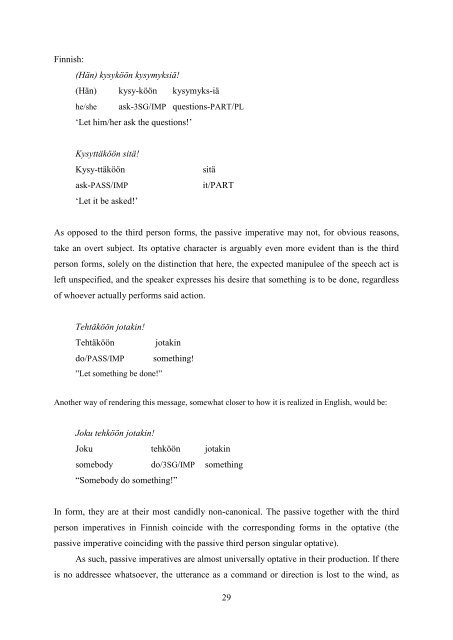The function of non-canonical imperatives in the languages of Europe
The function of non-canonical imperatives in the languages of Europe
The function of non-canonical imperatives in the languages of Europe
Create successful ePaper yourself
Turn your PDF publications into a flip-book with our unique Google optimized e-Paper software.
F<strong>in</strong>nish:<br />
(Hän) kysyköön kysymyksiä!<br />
(Hän) kysy-köön kysymyks-iä<br />
he/she ask-3SG/IMP questions-PART/PL<br />
‘Let him/her ask <strong>the</strong> questions!’<br />
Kysyttäköön sitä!<br />
Kysy-ttäköön<br />
ask-PASS/IMP<br />
‘Let it be asked!’<br />
sitä<br />
it/PART<br />
As opposed to <strong>the</strong> third person forms, <strong>the</strong> passive imperative may not, for obvious reasons,<br />
take an overt subject. Its optative character is arguably even more evident than is <strong>the</strong> third<br />
person forms, solely on <strong>the</strong> dist<strong>in</strong>ction that here, <strong>the</strong> expected manipulee <strong>of</strong> <strong>the</strong> speech act is<br />
left unspecified, and <strong>the</strong> speaker expresses his desire that someth<strong>in</strong>g is to be done, regardless<br />
<strong>of</strong> whoever actually performs said action.<br />
Tehtäköön jotak<strong>in</strong>!<br />
Tehtäköön jotak<strong>in</strong><br />
do/PASS/IMP someth<strong>in</strong>g!<br />
”Let someth<strong>in</strong>g be done!”<br />
Ano<strong>the</strong>r way <strong>of</strong> render<strong>in</strong>g this message, somewhat closer to how it is realized <strong>in</strong> English, would be:<br />
Joku tehköön jotak<strong>in</strong>!<br />
Joku tehköön jotak<strong>in</strong><br />
somebody do/3SG/IMP someth<strong>in</strong>g<br />
“Somebody do someth<strong>in</strong>g!”<br />
In form, <strong>the</strong>y are at <strong>the</strong>ir most candidly <strong>non</strong>-ca<strong>non</strong>ical. <strong>The</strong> passive toge<strong>the</strong>r with <strong>the</strong> third<br />
person <strong>imperatives</strong> <strong>in</strong> F<strong>in</strong>nish co<strong>in</strong>cide with <strong>the</strong> correspond<strong>in</strong>g forms <strong>in</strong> <strong>the</strong> optative (<strong>the</strong><br />
passive imperative co<strong>in</strong>cid<strong>in</strong>g with <strong>the</strong> passive third person s<strong>in</strong>gular optative).<br />
As such, passive <strong>imperatives</strong> are almost universally optative <strong>in</strong> <strong>the</strong>ir production. If <strong>the</strong>re<br />
is no addressee whatsoever, <strong>the</strong> utterance as a command or direction is lost to <strong>the</strong> w<strong>in</strong>d, as<br />
29
















